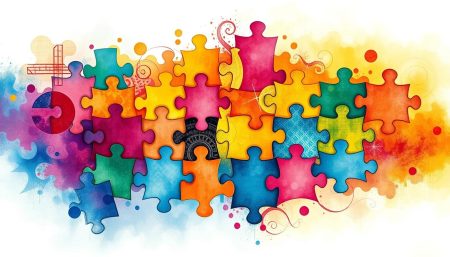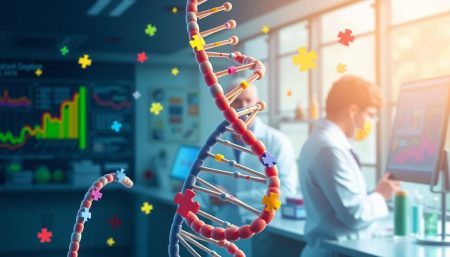Autism Spectrum Disorder (ASD) is a tough neurodevelopmental disorder in the United States. Autism Speaks explains it as a complex condition. It affects social interaction, communication, and causes repetitive behaviors.
Every person with ASD is different. This means we need to understand each one in their own way. This helps us support them better and raise awareness about autism.
The Centers for Disease Control and Prevention (CDC) says autism is common in many families. This shows we need to know more and share resources. The National Institute of Neurological Disorders and Stroke (NINDS) helps us understand autism’s brain complexity.
By learning more and sharing what we know, we can help our communities. We can create a place where people with ASD can grow and be supported.
What is Autism Spectrum Disorder (ASD)?
Autism Spectrum Disorder (ASD) is a complex condition that affects people differently. It is widely recognized by doctors and impacts how people communicate, behave, and interact with others. The DSM-5 by the American Psychiatric Association helps diagnose ASD, showing it’s unique for each person.
Defining Autism as a Neurodevelopmental Condition
ASD is marked by delays in social skills, communication, and repetitive behaviors. These key areas help us understand autism’s core traits. While autism is present from childhood, it might not be diagnosed until later, depending on the symptoms’ visibility and impact.
Characteristics of the Autism Spectrum
People with ASD have their own strengths and challenges. A study in “Nature” found common traits include social communication issues, intense interests, sensory sensitivities, and a need for routine.
Understanding ASD’s wide range is essential. The World Health Organization points out that autism’s traits vary greatly. This affects each person differently, with unique challenges and abilities.
Early Signs and Symptoms of Autism
Spotting the early signs of autism is key for effective treatment and early help. These signs can be subtle, but knowing them well can lead to early action. This action can greatly improve a child’s future development.
Recognizing the Early Indicators in Children
The National Autism Association says some early signs include little eye contact and no typical babbling. Children might also have delayed speech and not respond to their name. Finding these signs early and getting a professional diagnosis is the first step towards helping.
Decoding Communication and Behavioral Symptoms
A study in the Journal of Autism and Developmental Disorders found early signs in toddlers. These include few gestures and facial expressions. Also, kids with autism might repeat actions and hate changes in their routine.
“Pediatrics,” the journal of the American Academy of Pediatrics, stresses the importance of early detection. This allows doctors to suggest treatments that fit each child’s needs.
By spotting and acting on autism symptoms early, parents and caregivers can make important changes. These changes help kids get the best care and education possible.
The Causes and Influences Behind ASD
Understanding Autism Spectrum Disorder (ASD) means looking at genetic factors, environmental factors, and other risk factors for autism. Studies show that many things work together to affect how ASD shows up. This mix of influences changes the risk and how ASD is seen in different people.
The Simons Foundation Autism Research Initiative found that ASD isn’t caused by one gene. Instead, many genes work together. This shows how important genetic factors are in autism, even though the genetics are complex.
The Centers for Disease Control and Prevention (CDC) has looked into environmental factors a lot. They’ve found that things like what happens before and after birth can affect ASD risk. Important things include the health of the mom during pregnancy and exposure to certain substances or not enough nutrients.
A study in Molecular Psychiatry also talked about risk factors for autism. They looked at things like how old the parents were when they had the child, how much vitamin the mom took during pregnancy, and exposure to toxins. These things don’t mean someone will definitely get ASD. But they are part of the bigger picture that might make someone more likely to have it.
Research from many fields gives us a detailed view of what causes ASD. To understand why ASD happens and how it varies, here’s a table that shows how genes and environment work together:
| Aspect | Genetic Influence | Environmental Influence |
|---|---|---|
| Prevalence of Contribution | Highly Significant | Significant |
| Common Factors | Gene mutations, Family history | Prenatal exposure to toxins, Maternal health |
| Interplay with Other Factors | Interaction with environmental factors | Modulated by genetic predispositions |
By studying genetic and environmental factors and how they work together, scientists are getting closer to understanding risk factors for autism. This knowledge helps them find better ways to help and prevent ASD in the future.
Autism Spectrum Disorder and Autism Diagnosis Process
Understanding how to diagnose autism is key for early help and support. Doctors use special tools and methods to find and diagnose autism. This helps us understand the complex nature of autism spectrum disorders.
Assessment Tools and Criteria for ASD Diagnosis
Doctors use a mix of tools to check behavior and past development. The Autism Diagnostic Interview-Revised (ADI-R) and the Autism Diagnostic Observation Schedule (ADOS) are key tools. They help spot different signs of autism in people of all ages and levels of severity.
The Role of Healthcare Professionals in Identifying ASD
Pediatricians and other health experts play a big role in finding autism early. The American Academy of Neurology shows how a team effort helps in diagnosing autism. This is important for getting help to those who need it quickly.
Worldwide, there are set standards for finding autism, as seen in “The Lancet”. But, these standards need to be flexible to fit the many ways autism can show up. This shows the importance of a personalized and caring approach in diagnosing autism.
| Assessment Tool | Focus Area | Utilized by Professionals |
|---|---|---|
| ADI-R | Developmental History | Psychologists, Psychiatrists |
| ADOS | Behavioral Analysis | Speech-Language Pathologists, Clinical Psychologists |
Exploring the Variability in Autism Symptoms
The autism spectrum includes a wide range of symptoms and functionality levels in autism. These levels affect how people live their daily lives and interact with others. Looking into these areas, we see more than just medical terms. We learn about the real-life experiences of those facing these challenges.
Understanding High Functioning and Low Functioning Autism
High functioning and low functioning autism are terms often used in research. They show the wide range of functionality levels in autism. Yet, these labels are seen as too simple and not fully accurate in describing what someone on the autism spectrum can do.
The Impact of Autism on Social Interactions and Behaviors
Studies, like those in the Harvard Review of Psychiatry, show that social challenges in autism vary a lot. People with autism may struggle to make friends, understand social signals, or follow social rules. This makes social interactions a complex challenge for each person.
Stories from the Interactive Autism Network give us a closer look at these social challenges. They mix personal experiences with scientific findings. This helps us understand how autism affects daily life and behavior.
| Aspect | Challenges | Opportunities |
|---|---|---|
| High Functioning Autism | Subtle social cues misinterpretation | High academic and artistic achievement |
| Low Functioning Autism | Significant communication difficulties | Strong focus on specific interests |
| General Social Interaction | Difficulty in forming peer relationships | Potential for deep, meaningful connections in favorable environments |

Intervention Strategies for Autism Treatment
Choosing the right autism therapies can greatly improve the life and growth of those with autism. Applied Behavior Analysis (ABA) is key in creating strong treatment plans.
Behavioral Therapies and Their Effectiveness
Applied Behavior Analysis uses positive reinforcement to teach new behaviors. The Association for Science in Autism Treatment says ABA is a top choice for autism treatment. Studies show ABA helps improve good behaviors and reduce bad ones, as seen in the journal Behavior Modification.
Educational Programs Tailored for Autistic Learners
Special education for autism is vital for learning that meets each student’s needs. Research in the Journal of Autism and Developmental Disorders shows tailored education boosts skills. These strategies help students learn in ways that fit them best and create a supportive classroom.
Using the right mix of behavioral and educational methods can change how we treat autism. It offers a path that fits each person’s needs and is backed by science.
The Importance of Early Intervention in Autism
Understanding the critical importance of early treatment of autism is key. It shows how early childhood education and developmental progress work for kids with autism. The U.S. Department of Health & Human Services says these early steps can greatly improve a child’s thinking and social skills.
Looking closer, the Early Childhood Technical Assistance Center shares how states help with early intervention. This makes sure kids with autism get the right help early on. It helps them reach their full abilities through early childhood education.
The “Journal of Child Psychology and Psychiatry” also talks about the benefits of early help. It shows how kids grow better in thinking and talking. This proves why early treatment of autism is so important for lasting developmental progress.
| Early Intervention Aspect | Benefits |
|---|---|
| Enhanced Language Skills | Improves communication abilities and social interaction |
| Cognitive Development | Increases learning capacity and problem-solving skills |
| Social Adaptation | Facilitates better integration into school and community settings |
This early education method does more than meet immediate needs. It also prepares kids for success in school and life.
Family and Community Support for Autism Spectrum Disorders
People with autism spectrum disorders (ASD) do better with strong autism support systems. These systems include family resources and ASD community programs. Both are key to creating a welcoming and supportive place for everyone.
Navigating Family Dynamics with an ASD Diagnosis
Getting an ASD diagnosis can shake up family life and feelings. Studies in “The Journal of Pediatric Psychology” show families go through emotional changes. They need help to adjust and find ways to stay close.
Good autism support systems offer counseling and teach families how to cope. This helps families grow stronger together.
Community Resources and Support Networks
The Autism Society of America says community resources are vital. They offer support groups, educational events, and activities for people with ASD and their families. These help people stay involved and grow, as shown in the “American Journal of Community Psychology.”
The table below shows some important programs and resources in ASD community programs. It shows how far-reaching and impactful they are.
| Program | Location | Type of Support | Impact Reported |
|---|---|---|---|
| Next Step Workshops | Nationally | Job skills training | High |
| Family Support Network | Multiple States | Emotional and Educational Support | Medium to High |
| Social Integration Activities | Locally | Social Skills Development | Variable |
| Online Community Forums | Online | Peer Support and Information Sharing | Medium |
Using these family resources and ASD community programs helps manage ASD’s daily challenges. It also makes life better for individuals and their families. It helps the community understand and accept ASD better.
Living with ASD: Perspectives from Individuals and Families
Looking into personal experiences with autism helps us get a better picture of ASD daily life and how people cope. The Autistic Self Advocacy Network, Interactive Autism Network (IAN), and “The Reason I Jump” offer deep insights into what it’s like to live with Autism Spectrum Disorder.
People with autism often say their lives are filled with unique views and talents. But they also face big challenges in socializing, handling sensory inputs, and talking to others. These stories show how they find ways to manage their daily lives.
- Understanding Sensory Overload: Many share how hard it is to deal with too much sensory input. They talk about creating special environments to help them cope.
- Structured Routines: Having set routines is a big help. It gives a sense of safety and order, which reduces stress.
- Support Systems: Having a strong support network is key. Family, friends, and teachers play big roles in helping those with ASD.
Families are very important in supporting their loved ones with autism. Their stories of resilience and adapting to their family member’s needs are shared on IAN. These stories highlight the need for community support and understanding.
“The Reason I Jump” gives us a peek into the thoughts and feelings of those with autism. Books like this help change how people see autism. They offer a deep look into the daily struggles and thoughts of someone with ASD.
Learning about these coping mechanisms and strategies helps break down myths about ASD. It also makes our world more welcoming and supportive for those facing these challenges.
Myths and Misconceptions about Autism Debunked
To improve autism awareness, we must tackle common myths and misconceptions. These myths often confuse people about Autism Spectrum Disorder (ASD). We will use autism facts to clear up these misunderstandings, promoting a better understanding of this complex condition.
Confronting Stereotypes and Stigmas Around ASD
Many people believe autistic individuals lack emotions or are not smart. These beliefs are not only wrong but also harmful. They make it harder for people with autism to be accepted and included in society.
Studies in The Scientific Review of Mental Health Practice show these stereotypes are not true. They are backed by research and stories from the autism community. This helps us move towards a more accurate understanding of autism.
Countering Myths with Facts and Scientific Research
Scientific studies can help debunk myths about autism. For instance, the idea that vaccines cause autism is false, proven by many studies. The National Autistic Society offers important information that clears up these myths and explains what autism really is.
To improve autism awareness and understanding, we need to use facts to fight misconceptions. Here’s a table comparing common myths with the truth:
| Common Myth | Fact |
|---|---|
| Autistic people do not desire social interaction. | Many autistic individuals seek social connections but may communicate or interact in different ways. |
| Autism is caused by poor parenting. | Autism is a neurological disorder and not caused by parenting styles. |
| Autism can be cured. | While autism is lifelong, therapies and interventions can significantly improve skills and abilities. |
By focusing on autism facts and debunking autism myths, we’re working towards a more informed and inclusive society. We aim to respect the diversity and value of every individual with autism.
Educational Challenges and Opportunities for Autistic Individuals
Learning for autistic students is unique and needs a special educational framework. Laws like The Individuals with Disabilities Education Act (IDEA) help make education more personal and inclusive. These laws ensure public education meets the needs of all students, focusing on special education and learning accommodations.
Inclusive classrooms welcome students from all backgrounds, including those with autism. The National Center for Learning Disabilities says inclusive education is key for autistic students’ growth and success. Such classrooms offer fair educational chances that honor each student’s learning style.
Inclusive Education Strategies
Effective inclusive education strategies blend teaching methods for autistic students in regular classrooms. This method benefits all students, making learning more engaging and empathetic.
Customizing Learning Approaches for Students with Autism
A study in the “Journal of Autism and Developmental Disorders” shows tailored learning approaches help autistic students. Each autistic person is different, needing plans that fit their unique challenges and strengths. Important learning aids might include structured settings, visual tools, and technology to help them learn better.
The aim of special education in inclusive classrooms is to help autistic students reach their highest abilities. As we learn more, it’s vital to keep educational plans flexible to meet the changing needs of all students.
How Technology Aids in Autism Communication and Learning
Using assistive technology has changed how people with autism communicate and learn. AAC devices are key, as said by The American Speech-Language-Hearing Association. They help those who can’t speak well or at all to share their thoughts.
The Office of Educational Technology talks about how digital learning tools make learning personal for students with autism. These tools include apps and software. They’re made to improve how people with autism talk and interact with others.
- Visual learning apps: These apps use bright, engaging visuals to teach language, numeracy, and life skills.
- Interactive storybooks: Tailored to enhance reading skills and social understanding.
- Social narratives: Digital tools that help students understand and manage social interactions.
The “Journal of Special Education Technology” looked into new tech that helps students with ASD. It makes learning better and lets students be more independent. This tech is changing how we teach and making learning more personal and easy to get to.
Advancements in Research and Understanding of Autism Spectrum Disorder
The world of autism research has changed a lot in recent years. We’ve learned more about neurological studies and genetic links to autism. These new insights help us understand Autism Spectrum Disorder (ASD) better. They also lead to new treatments and ways to diagnose it.
Genetic studies have made big discoveries, as seen in Nature Genetics. They found new genetic changes linked to ASD. This knowledge could lead to treatments tailored to each person.
New Findings in Genetics and Neuroscience
Recent neurological studies have shown how autism affects the brain. Research in Neuron found differences in brain connections and activity. This helps explain why people with ASD have different symptoms. Knowing this, we can create treatments that fit each person’s brain.
The Future of Autism Research: Possible Breakthroughs
The Simons Foundation Autism Research Initiative sees a bright future for autism research. New tools in genome editing and neuroimaging could change how we understand genetic links to autism. This could lead to better treatments and a better life for those with ASD.
This ongoing progress brings hope for a future where ASD is better understood. It could also reduce the stigma around it.
Autism Awareness and Acceptance in Society
In recent years, society’s view on autism spectrum disorder (ASD) has changed a lot. This change is thanks to hard work by groups like Autism Speaks and the Autistic Self Advocacy Network (ASAN). They push for inclusive policies to help everyone understand and support autism better.
This shift shows a bigger change in how we see diversity. It’s about realizing the value people with autism add to our world. It’s also about fighting the old stigma around autism.
Promoting a More Inclusive Environment
To make a place more inclusive, we need to do many things. We must raise awareness, change how people think, and offer real support for those with ASD. Education is key in fighting myths and making people ready to support those with autism.
Autism Advocacy and Public Policy Changes
Advocacy for laws is important for getting the help and rights people with autism need. ASAN works hard to make sure laws help the autistic community. This helps people with autism live better without facing unfair treatment.
Autism acceptance means big changes in laws and how places work. These changes help people with ASD reach their goals without facing unfair treatment.
| Initiative | Organization | Impact |
|---|---|---|
| Diverse Abilities Campaign | Autism Speaks | Increased awareness and support networks |
| Rights Advocacy | ASAN | Policy frameworks revised for better inclusivity |
| Community Education | Local NGO Initiatives | Improved societal attitudes toward ASD |
It’s important for everyone to help these efforts move forward. Whether it’s through action or supporting the cause, we must keep pushing for a more inclusive world.
Breaking Down Barriers: Employment Prospects for Autistic Adults
Many efforts are underway to improve autism employment and ensure workplace inclusion. These initiatives aim to provide job opportunities for ASD individuals. They highlight the skills and abilities autistic people bring to the workplace.

The Department of Labor’s Office of Disability Employment Policy offers many resources. These help organizations hire more autistic people. This move brings in diverse views and boosts innovation.
The ‘Autism at Work’ initiative is a key example of success. It shows how companies can include autistic employees well. These companies see their autistic team members as dedicated and skilled in analysis.
A study in Autism Research journal found autistic adults face challenges in jobs. But, with the right support and hiring methods, these challenges can be lessened.
| Challenge | Strategy | Outcome |
|---|---|---|
| Social Interaction | Workplace mentors and inclusive training programs | Improved team cohesion and understanding |
| Routine Adjustments | Flexible scheduling and task customization | Enhanced job satisfaction and productivity |
| Communication Barriers | Visual aids and clear, structured communication | More effective and inclusive workplace communication |
This approach supports workplace inclusion efforts. It shows autistic employees can thrive with the right support. They can excel in roles that match their strengths.
Autism Spectrum Disorder and Autism: A Detailed Look
Autism Spectrum Disorder (ASD) is a complex group of neurodevelopmental disorders. It affects social interaction, communication, and repetitive behaviors. Understanding autism is key, as each person with ASD is unique, with their own strengths and challenges.
The National Institute of Mental Health (NIMH) offers important autism resources. They stress the importance of accurate ASD understanding. This helps reduce misconceptions and increases support and care.
Comprehensive autism care requires a team effort. The Interagency Autism Coordinating Committee (IACC) helps by providing detailed reports and recommendations. Their work ensures that people with ASD get the support they need, from early childhood to adulthood.
Reports like those in the “Annual Review of Clinical Psychology” offer deep insights. They cover etiology, diagnosis, and treatment. These findings are essential for parents, educators, and healthcare professionals. As awareness grows, so does the range of autism resources, helping everyone reach their full ability.
FAQ
Q: What is Autism Spectrum Disorder (ASD)?
A: Autism Spectrum Disorder (ASD) is a condition that affects how people interact and communicate. It also affects their behavior. Each person with ASD is different, making it a spectrum condition.
Q: What are the early signs of autism in children?
A: Early signs of autism in kids include not wanting to play with others and not talking much. They might also repeat actions a lot and not like changes in their routine. It’s key to watch for these signs and talk to a doctor early.
Q: What causes Autism Spectrum Disorder?
A: There’s no single cause for ASD. But research shows it’s linked to genetics and the environment. Things like genetic changes, when parents were born, and exposure to toxins might play a role.
Q: How is Autism Spectrum Disorder diagnosed?
A: Doctors use special tests to diagnose ASD. These include the Autism Diagnostic Observation Schedule (ADOS) and the Autism Diagnostic Interview-Revised (ADI-R). Doctors, psychologists, and other specialists help with the diagnosis.
Q: What interventions are effective for treating autism?
A: Many treatments help with autism, with Applied Behavior Analysis (ABA) being very effective. Each treatment plan is made just for the person. It might include speech therapy, occupational therapy, and special education programs.
Q: Why is early intervention important for autism?
A: Early help can greatly improve a child’s life. It helps them learn and grow. Early intervention uses the brain’s ability to change and adapt, helping kids with autism.
Q: What support is available for families affected by autism?
A: Families get help through community programs, therapy, and support groups. There are also educational resources. These help families understand and manage autism, and support their child’s growth.
Q: How can you include an autistic individual in educational activities?
A: To include autistic students, teachers need to tailor their teaching. This means using methods that work best for each student. It also involves creating special plans and using individualized education programs (IEPs).
Q: What role does technology play in aiding individuals with autism?
A: Technology is very helpful for people with autism, helping with communication and learning. Tools like AAC devices and special software support their development and learning in a personalized way.
Q: What is the importance of autism research?
A: Research is key to understanding autism better. It helps find new treatments and improves how we diagnose it. It also helps us learn more about autism and its effects on people.
Q: How is society working towards autism acceptance and awareness?
A: Society is working hard to accept and understand autism. This includes advocacy, education campaigns, and policy changes. These efforts aim to make communities more supportive and inclusive for people with autism.
Q: What employment opportunities exist for adults with Autism Spectrum Disorder?
A: Adults with autism have more job chances than before. Programs like Autism at Work help companies hire them. These efforts focus on using the strengths of autistic individuals and providing support in the workplace.
Q: Are there extensive resources available for understanding Autism Spectrum Disorder?
A: Yes, there are many resources for learning about ASD. These include information from the National Institute of Mental Health (NIMH) and reports from the Interagency Autism Coordinating Committee (IACC. There are also review papers that summarize the latest research and practices.
Q: What are common myths about autism, and how can they be debunked?
A: Many myths surround autism, like thinking people with ASD are not smart or don’t feel emotions. These myths can be debunked with facts and research. Credible organizations help spread accurate information and challenge stereotypes.


















